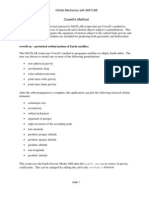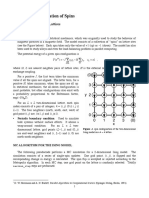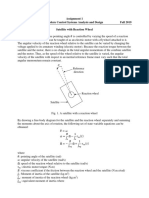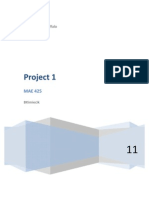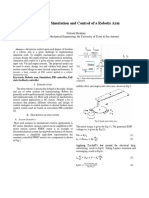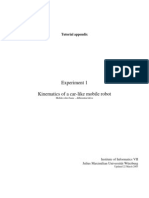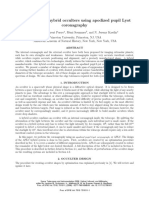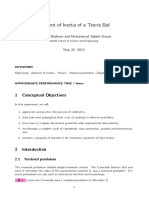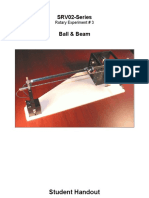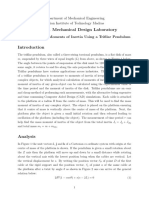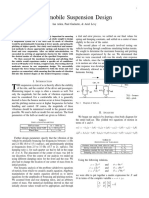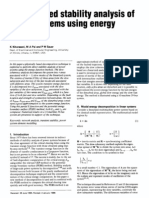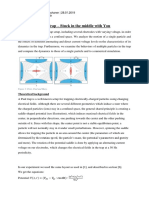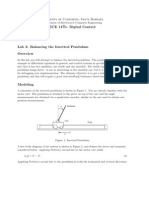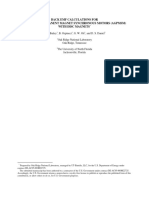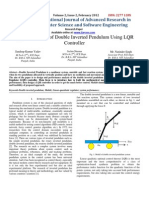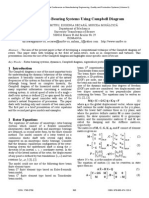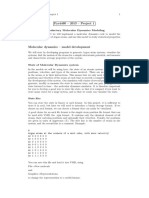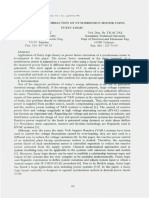ASEN3200 LabO3 2005
ASEN3200 LabO3 2005
Uploaded by
ChristianRomiSihombingCopyright:
Available Formats
ASEN3200 LabO3 2005
ASEN3200 LabO3 2005
Uploaded by
ChristianRomiSihombingOriginal Title
Copyright
Available Formats
Share this document
Did you find this document useful?
Is this content inappropriate?
Copyright:
Available Formats
ASEN3200 LabO3 2005
ASEN3200 LabO3 2005
Uploaded by
ChristianRomiSihombingCopyright:
Available Formats
ASEN 3200 Orbit Mechanics / Attitude Dynamics & Control Lab O-3 Assigned 2/18/05, Due 3/1/05
The potential function and equations of motion for a satellite perturbed by Earth oblateness are given below. U X X U Y = [ U ]ECI = Y Z ECI U Z
2 J2 R Z2 U = 1 + 1 3 2 , E = r 2 r r ECI
v2 U 2
= U = U I + U J + U K = XI + YJ + ZK r X Y Z where
2 2 = X 1 3 J 2 R 5 Z 1 X 2 r3 2 r r Y Y= X X 2 2 = Z 1 3 J 2 R 5 Z 3 Z 2 3 r 2 r r J 2 = 0.00108263,
= 398600.4418 km
R = 6378.137km
s2
J2, , and R are parameters for the JGM-2 gravity field. E is the total energy and will be constant for a potential function dependent only on zonal harmonics. The initial conditions for an orbit are given as follows: P=6200.0 sec, e=0.001, i=45, (RAAN) = 10.0, = 45, =315. Use an epoch and initial time of 1 Jan 2004 00:00:00 and the J2000 coordinate system. Use a stop time that is three orbit periods later. Assume the orbit is perturbed only by Earth oblateness, J2. Perform the following study: 1. Write the appropriate Matlab code and numerically integrate the equations of motion given above in the ECI Cartesian frame for three revolutions. Compute and store the orbit elements and ECI Cartesian coordinates at 1 min intervals. Starting with the same 1
initial conditions, generate the ECI Cartesian coordinates for a two-body orbit for the same time interval. a. Plot the orbit elements, the energy deviation from its epoch value, and the deviation of the Z component of angular momentum from its epoch value for the perturbed orbit. Both the energy and hz should deviate from their epoch values by around 10-7 if your integration is done properly. Use the equation for energy given above. b. Generate a file of Cartesian position coordinate differences between the perturbed and two body orbits ( rpeturbed r2 body ). c. Code the RIC transformation matrix and plot the RIC differences using the twobody orbit as the reference. 2. Generate the perturbed orbit using STK. You will need to choose HPOP (High Precision Orbit Propagator) from the satellite basic properties. After choosing HPOP, click on the force model and choose the JGM2 gravity model. Set the maximum degree to 2 and the maximum order to 0. This will select J2 as the perturbing force. Turn off all other perturbing forces (drag, solar pressure, lunar, and solar gravity). Generate the RIC plots between the perturbed orbit and the two-body orbit as the reference using STK. Your RIC plots should look identical to those from MATLAB. You may want to do the STK plots first so that you will know if your MATLAB results are correct. 3. Your report should contain the following plots a. Plots of the orbit elements (a, e, i, , ,Tp), and the energy and hz deviations for your perturbed orbit generated with MATLAB. Do not plot the true anomaly. b. RIC differences between your perturbed and two body orbits. c. RIC differences between STKs perturbed and two-body orbit. 4. In addition to observations you wish to make, discuss the following topics in your report: a. Verify the differential equations of motion by generating the partial derivative, U , by hand as requested in the pre-lab assignment. X b. Describe the variations of the orbit elements and note the frequencies that are present, i. e., secular, short period, and long period. Can you detect any long period perturbations? Why or why not? Is the energy and hz constant? c. Discuss the RIC result. What is the direction of the dominant variation from the two-body orbit? Why does the major perturbation occur in this direction? d. Do the STK results differ from yours? If so, why?
The RIC transformation for part 1 is obtained as follows (see also the handout on coordinate systems). Given the position and velocity vector of the reference orbit in the ECI frame, we have j r = Xi + Y + Zk,
j r = Xi + Y + Zk, h = r r, then, r R= , r h C= , h I =CR In matrix notation, R R R R i i y z x XYZ j j I = I x I y I z = [T ]RIC C C C y z k C x k Note that the elements of the RIC transformation matrix at each point are the components of the RIC unit vectors. Hence, R X I = T XYZ Y [ ]RIC C Z
Pre-Lab assignment:
U Verify the equation for X by forming . X
PROGRAMING NOTES The ode45 integrator in matlab is a variable step integrator. This means that it chooses its own step size based on default tolerances built into the program. These tolerances are very loose and as a result ode45 gives very poor results when integrating the orbit equations of motion. To solve this problem you can reset the tolerances by replacing the [t,x] statement with the following. tol = 1e-10; options = odeset('RelTol',tol,'AbsTol',tol); 3
[t,x] = ode45('YourDerivativeFunction', time, x0, options) the time array can be defined as time=(0:60:18600) Where 0 is the initial time, 60s is the time step at which the ephemeris will be returned and 18600 sec is the final time.
You might also like
- La Ligera Ventaja by Jeff Olson PDFDocument6 pagesLa Ligera Ventaja by Jeff Olson PDFcontaigq33% (6)
- LitCharts War PhotographerDocument18 pagesLitCharts War PhotographerDavid100% (1)
- ENSC3001 - Exam NotesDocument13 pagesENSC3001 - Exam NotesGeoffreyWanNo ratings yet
- Difference Between Policy and StrategyDocument4 pagesDifference Between Policy and StrategyAbu Taleb83% (6)
- Coopertitchener Trifilar1Document30 pagesCoopertitchener Trifilar1api-24490620450% (2)
- Modeling, Simulation and Control of A Robotic ArmDocument7 pagesModeling, Simulation and Control of A Robotic ArmaseptaNo ratings yet
- Cowell's Method: Cowell1.m - Perturbed Orbital Motion of Earth SatellitesDocument25 pagesCowell's Method: Cowell1.m - Perturbed Orbital Motion of Earth Satellitesbaixiu0813No ratings yet
- Transportation-Steps For Customization-SAP LESDocument39 pagesTransportation-Steps For Customization-SAP LESrparnapa100% (9)
- The Cambridge History of Jewish Philosophy Vol 1 PDFDocument899 pagesThe Cambridge History of Jewish Philosophy Vol 1 PDFG Maria Grigore100% (13)
- Lab 3 - Gyroscope Stabilized PlatformDocument13 pagesLab 3 - Gyroscope Stabilized PlatformFabian ZenderNo ratings yet
- Lab5a Fa10Document4 pagesLab5a Fa10alexlenevez_12130% (1)
- Inverse Kinematics Problem (Ikp) of 6-Dof Manipulator by Locally Recurrent Neural Networks (LRNNS)Document5 pagesInverse Kinematics Problem (Ikp) of 6-Dof Manipulator by Locally Recurrent Neural Networks (LRNNS)yousif al mashhadanyNo ratings yet
- Modelo de Ising 2d PDFDocument29 pagesModelo de Ising 2d PDFFidel RomanNo ratings yet
- Expt 5 236Document28 pagesExpt 5 236saragaNo ratings yet
- Keplerian Orbits in Space-Fixed Earth-Fixed and Topocentric Systems PDFDocument17 pagesKeplerian Orbits in Space-Fixed Earth-Fixed and Topocentric Systems PDFSamuel gultomNo ratings yet
- Assignment 1 ENEE 3790 Modern Control Systems Analysis and Design Fall 2019 Satellite With Reaction WheelDocument2 pagesAssignment 1 ENEE 3790 Modern Control Systems Analysis and Design Fall 2019 Satellite With Reaction WheelSajjad AhmedNo ratings yet
- Assignment 1 PDFDocument2 pagesAssignment 1 PDFSajjad AhmedNo ratings yet
- Project 1Document13 pagesProject 1Brian KimiecikNo ratings yet
- Modeling, Simulation and Control of A Robotic Arm PDFDocument7 pagesModeling, Simulation and Control of A Robotic Arm PDFshivaramreddyNo ratings yet
- Physics 9C Midterm 2 SolutionsDocument7 pagesPhysics 9C Midterm 2 SolutionsTiffany LeeNo ratings yet
- Differential Drive KinematicsDocument10 pagesDifferential Drive Kinematicsnesquik_snackNo ratings yet
- Study of The Kitaev Models: Arnab Barman RayDocument20 pagesStudy of The Kitaev Models: Arnab Barman RayArnab Barman RayNo ratings yet
- Comparison Between Full Order and Minimum Order Observer Controller For DC MotorDocument6 pagesComparison Between Full Order and Minimum Order Observer Controller For DC MotorInternational Journal of Research and DiscoveryNo ratings yet
- Satellite ReportDocument87 pagesSatellite Reportkvk808No ratings yet
- TheodoliteDocument9 pagesTheodoliteSunil NepalNo ratings yet
- Homework # 3Document2 pagesHomework # 3eniNo ratings yet
- Non-Linear Discrete Model of BLDC Motor For StudyiDocument7 pagesNon-Linear Discrete Model of BLDC Motor For StudyiMuhammad Aseer KhanNo ratings yet
- Motion of A Spinning Top: Quaternion AlgebraDocument11 pagesMotion of A Spinning Top: Quaternion AlgebraXàîñï ChÔhàñNo ratings yet
- GyroscopeDocument12 pagesGyroscopeAnonymous 6TKQ1aIwNo ratings yet
- Adaptive State Controller For Inverted Pendulum: Nenad Muškinja, Boris TovornikDocument6 pagesAdaptive State Controller For Inverted Pendulum: Nenad Muškinja, Boris TovornikNeagu AdrianNo ratings yet
- Kane MethodDocument7 pagesKane MethodHùng FlyNo ratings yet
- Performance of Hybrid Occulters Using Apodized Pupil Lyot CoronagraphyDocument7 pagesPerformance of Hybrid Occulters Using Apodized Pupil Lyot CoronagraphyBubu BibuNo ratings yet
- Problem SetDocument3 pagesProblem SetUday RameshNo ratings yet
- Moment of Inertia of A Tennis BallDocument8 pagesMoment of Inertia of A Tennis BallShaheer ShahzadNo ratings yet
- Design of Optimal PID Controller For Inverted Pendulum Using Genetic AlgorithmDocument3 pagesDesign of Optimal PID Controller For Inverted Pendulum Using Genetic AlgorithmPhuongle LeNo ratings yet
- Launch - Installation and Propulsion Control Satellite Loca Tor SystemDocument6 pagesLaunch - Installation and Propulsion Control Satellite Loca Tor SystemIon CorbuNo ratings yet
- Brent and McMillan - 2021 - Some New Algorithms For High-Precision ComputationDocument9 pagesBrent and McMillan - 2021 - Some New Algorithms For High-Precision ComputationsizukhuranaNo ratings yet
- Design and Simulation of Control System For Bearingless Synchronous Reluctance Motor PDFDocument5 pagesDesign and Simulation of Control System For Bearingless Synchronous Reluctance Motor PDFKrishnam NaiduNo ratings yet
- 2017 ICSV Det of Unb in A Ror BRG SystemDocument7 pages2017 ICSV Det of Unb in A Ror BRG SystemAka ShriNo ratings yet
- SRV02-Series Ball & Beam: Student HandoutDocument13 pagesSRV02-Series Ball & Beam: Student HandoutKeli KeyNo ratings yet
- Mtech Lab Pendulum WriteupDocument4 pagesMtech Lab Pendulum Writeupprincessaadhya29No ratings yet
- Sr. No. Practical 1: Static and Dynamic Balancing of Rotating MassesDocument21 pagesSr. No. Practical 1: Static and Dynamic Balancing of Rotating MassesFa CaNo ratings yet
- Automobile Suspension Design: Ian Arlen, Paul Gu Enette, & Ariel LevyDocument10 pagesAutomobile Suspension Design: Ian Arlen, Paul Gu Enette, & Ariel LevyHermesNo ratings yet
- ME5205: Theory of Vibrations: Assignment 3 Systems With Multiple Degrees of Freedom Date of Submission: 6 November 2019Document3 pagesME5205: Theory of Vibrations: Assignment 3 Systems With Multiple Degrees of Freedom Date of Submission: 6 November 2019Dinesh BompadaNo ratings yet
- Power Systems Using Energy Functions: Modal-Based Stability Analysis ofDocument6 pagesPower Systems Using Energy Functions: Modal-Based Stability Analysis ofAmel ZeriguiNo ratings yet
- Discretization To Avoid Singularities in Vibration-Rotation Hamiltonians: Bisector Embedding For AB2 TriatomicsDocument12 pagesDiscretization To Avoid Singularities in Vibration-Rotation Hamiltonians: Bisector Embedding For AB2 TriatomicsPassammNo ratings yet
- EE 483 Exam 1 - SolutionsDocument8 pagesEE 483 Exam 1 - Solutionsరవితేజ నంబూరుNo ratings yet
- 11 2017jamdsm0080Document12 pages11 2017jamdsm0080Traore k.B.ClenaNo ratings yet
- Paul Trap - Ben and MichaelDocument8 pagesPaul Trap - Ben and Michaelbenshenhar7682No ratings yet
- Lab3 v2Document10 pagesLab3 v2Pranshumaan SinghNo ratings yet
- Back Emf Calculations For Axial-Gap Permanent Magnet Synchronous MotorsDocument7 pagesBack Emf Calculations For Axial-Gap Permanent Magnet Synchronous Motorsyasserali.1041992No ratings yet
- Optimal Control of Double Inverted Pendulum Using LQR ControllerDocument4 pagesOptimal Control of Double Inverted Pendulum Using LQR ControllerSachin SharmaNo ratings yet
- Exam 1993Document14 pagesExam 1993Andi SuntoroNo ratings yet
- Study of Rotor-Bearing Systems Using Campbell DiagramDocument4 pagesStudy of Rotor-Bearing Systems Using Campbell DiagrammishraenggNo ratings yet
- Controller Design of Inverted Pendulum Using Pole Placement and LQRDocument7 pagesController Design of Inverted Pendulum Using Pole Placement and LQRInternational Journal of Research in Engineering and Technology100% (1)
- Fys4460 - 2013 - Project 1: Introductory Molecular Dynamics ModelingDocument8 pagesFys4460 - 2013 - Project 1: Introductory Molecular Dynamics ModelingcykNo ratings yet
- Selby Trapp Final ReportDocument28 pagesSelby Trapp Final ReportothmanNo ratings yet
- Mathematical Modeling of Mechanical Systems and Electrical SystemsDocument49 pagesMathematical Modeling of Mechanical Systems and Electrical SystemsMary DunhamNo ratings yet
- DOM-I-Force Analysis PDFDocument26 pagesDOM-I-Force Analysis PDFNaveenKrishNo ratings yet
- lISTA 1Document9 pageslISTA 1Rafael Jardineiro SantosNo ratings yet
- Atomic Photoionization in The Born Approximation and Angular Distribution of PhotoelectronsDocument13 pagesAtomic Photoionization in The Born Approximation and Angular Distribution of Photoelectronspcd09No ratings yet
- Mca 01 00066Document7 pagesMca 01 00066djkeags24No ratings yet
- KeplerDocument7 pagesKeplerruloneggerNo ratings yet
- Student Solutions Manual to Accompany Economic Dynamics in Discrete Time, second editionFrom EverandStudent Solutions Manual to Accompany Economic Dynamics in Discrete Time, second editionRating: 4.5 out of 5 stars4.5/5 (2)
- Robot Manipulators: Modeling, Performance Analysis and ControlFrom EverandRobot Manipulators: Modeling, Performance Analysis and ControlNo ratings yet
- Hepatobiliary SystemDocument131 pagesHepatobiliary SystemCurt Leye RodriguezNo ratings yet
- 1892 ActDocument2 pages1892 Actsantosh kumarNo ratings yet
- Lipid Metabolism and Health - EBOOKOID PDFDocument377 pagesLipid Metabolism and Health - EBOOKOID PDFniluh suwasanti100% (1)
- Le Thi Nhut Anh-CV-EngDocument5 pagesLe Thi Nhut Anh-CV-EngBánh BèoNo ratings yet
- Department of Education: I. Encircle The Letter of The Correct AnswerDocument2 pagesDepartment of Education: I. Encircle The Letter of The Correct AnswerJhonabie Suligan Cadeliña100% (2)
- The True Gospel and The False EnglishDocument3 pagesThe True Gospel and The False Englishmichaeledem_royalNo ratings yet
- Newton Laws - Angel and AshleyDocument4 pagesNewton Laws - Angel and Ashleyapi-438888114No ratings yet
- Sounds & Spelling of Irish/Fuaimeanna Agus Litriú Na GaeilgeDocument4 pagesSounds & Spelling of Irish/Fuaimeanna Agus Litriú Na GaeilgeJoy L AndersonNo ratings yet
- CaringDocument29 pagesCaringkikiNo ratings yet
- Alcohol, Phenol and EtherDocument36 pagesAlcohol, Phenol and EtherRajdeep GoswamiNo ratings yet
- Paestum: History of Architecture 1Document16 pagesPaestum: History of Architecture 1Reigh FrNo ratings yet
- LPM 402 - Research MethodsDocument3 pagesLPM 402 - Research MethodsJ. C.No ratings yet
- Clavister Virtual Core Series Vmware Getting Started Guide 12.00.05 enDocument85 pagesClavister Virtual Core Series Vmware Getting Started Guide 12.00.05 enNizar Hajji karwiNo ratings yet
- Roller, Duane W. - The Building Program of Herod The GreatDocument177 pagesRoller, Duane W. - The Building Program of Herod The GreatNicéphore Jünge100% (2)
- Ionut TintaruDocument6 pagesIonut TintaruBalent AndreeaNo ratings yet
- Marketing Strategy Starbucks IndiaDocument5 pagesMarketing Strategy Starbucks IndiaMohammad Imad Shahid Khan100% (1)
- Assessment Construction Final DraftDocument25 pagesAssessment Construction Final Draftapi-220363031No ratings yet
- Article 21 of The Constitution of India - Right To Life and Personal Liberty - AcademikeDocument57 pagesArticle 21 of The Constitution of India - Right To Life and Personal Liberty - AcademikeYagya RajawatNo ratings yet
- PDQ Session 1Document4 pagesPDQ Session 1api-403189689No ratings yet
- Lesson 8: Autobiography, Biography, Personal Narrative, and Travelogue Lesson 8: Autobiography, Biography, Personal Narrative, and TravelogueDocument25 pagesLesson 8: Autobiography, Biography, Personal Narrative, and Travelogue Lesson 8: Autobiography, Biography, Personal Narrative, and TravelogueEthel BustamanteNo ratings yet
- Skripsi Buzz GroupsDocument38 pagesSkripsi Buzz GroupsBrahmadi Ajie YogyaNo ratings yet
- Week 11 Powerpoint SLP Forensic ChemistryDocument52 pagesWeek 11 Powerpoint SLP Forensic ChemistrySheena De Guzman MorenoNo ratings yet
- Mayo V SatanDocument2 pagesMayo V SatanRix MigriñoNo ratings yet
- Introduction To Debt PolicyDocument8 pagesIntroduction To Debt PolicyRatnesh DubeyNo ratings yet
- Electron Config Dorm LPDocument3 pagesElectron Config Dorm LPJoric MagusaraNo ratings yet






